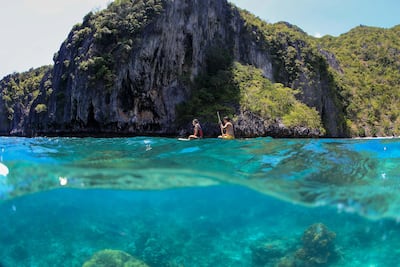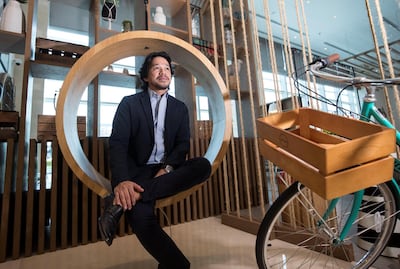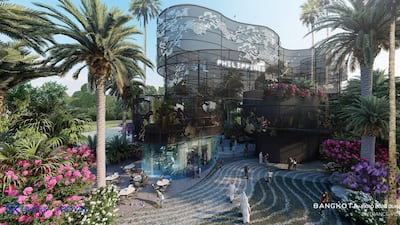The vital need to safeguard precious marine life across thousands of islands in the Philippines from a growing climate change threat is at the heart of the country's global message at Expo 2020 Dubai.
A grey graphite wire mesh will curve around artificial coral atolls and reefs as part of the pavilion offering at the eagerly awaited world fair.
Gaps in the aluminium and steel panels will filter sunlight on to porous concrete clusters that represent the reefs as digital videos bring the seabed to life.
The pavilion’s darkened interior will be used to project stunning images of bright-coloured fish and marine organisms to portray the underwater landscape.
The Philippines is the world’s third most coral-rich area after Indonesia and Australia.
Architects from the Philippines are in the UAE this week for the first reveal of their country's pavilion that centres on bangkota, an ancient Tagalog word for coral reef.
“The screen mesh and expanded wire fencing will create a metaphor for the coral reef and underwater world that is a diver’s paradise,” said Royal Pineda, director for theme development and architect of the Philippine pavilion.
“When people enter, although they are walking on the ground, they will see the colours of the sea.”
A vital part of the ocean ecosystem, coral reefs are threatened by global warming and pollution.
There has been a marked decline in the condition of reefs across the world with environmentalists rekindling conversations to guard against damage and loss.
Conservationists in the Philippines spread awareness among fishermen about plastic nets entangled on corals atolls and islands. Educational sessions are organised in local communities, schools and colleges.
“We want to ask that this rich underworld is protected and life forms continue to be supported,” Mr Pineda said.
“People usually convey sustainability with technology but instead of displaying a physical product we want to show nature surrounding our country.
“We will ask people to embrace their responsibility to nature so they continue to enjoy the beauty of the reefs.”
The pavilion will be located in the expo’s sustainability section and planners have focused on innovative architecture.
All material will be sourced from the UAE in line with the country’s aim to produce a truly sustainable pavilion.
Trees and plants such as the flame or fire tree that grow in the UAE and the Philippines will be planted near artificial coral lagoons.
The Delonix regia sprouts fiery red, orange and yellow flowers in the UAE and also announces the arrival of the monsoon in the Philippines.
At 1,300 square metres, the pavilion may be smaller compared to mega structures being curated by other nations but clearly will not be dwarfed in its message.
“Philippines is not a first world country but that does not mean we cannot dream for better. Being a developing country is not a limitation,” Mr Pineda said.
“We may have a smaller budget and our pavilion may be smaller in size but we want to show how from humble material the Philippines can create luxurious design.”

Visitors will be invited to walk in a garden dotted with date palms and up to decks on higher levels of the pavilion.
The country boasts some of the world’s top diving sites and the Tubbataha Reef Natural Park is a Unesco World Heritage Site. The pavilion seeks to address the lack of awareness among Filipinos about their heritage.
Once the expo ends in April 2021, organisers will rebuild the structure in New Clark City, a green, high tech metropolis being built 100km north of Manila.
“When we dismantle in Dubai, it will go back as a gift to the Philippines,” Mr Pineda said.

“People in the Philippines know of the reefs but are not well aware it is home to so many species. We hope to educate people so they respect it.”
The country has been in the news recently after it returned dozens of shipping containers full of trash to Canada in a spat over waste exports.
The Philippines declared the import of 2,400 tonnes of Canadian waste illegal following the mislabelling of plastics for recycling.
Canada maintains the waste exported in 2013-14 was part of a private contract and did not have government approval.
Other developing nations have backed the Philippines and plan to do the same.
Is the expo pavilion part of a Filipino message that they want their voice heard?
“It’s about defining who we are as a people, we do not disrespect others and people should do the same with us,” Mr Pineda said.
"In sustainability issues too, you should not violate your neighbour. The bangkota is about oneness and by announcing how we are all connected, we hope it creates more respect for nature and each other. What you don't want done to you, you should not do to others."
Work on the pavilion will begin in January for the expo set to open in October next year.

